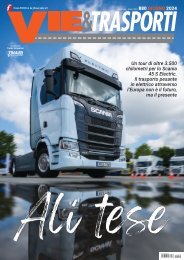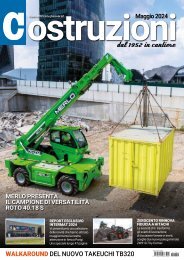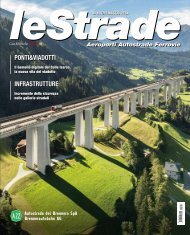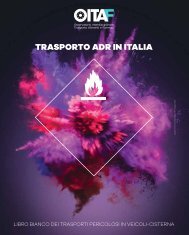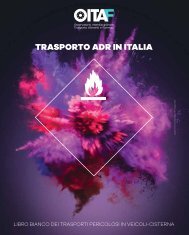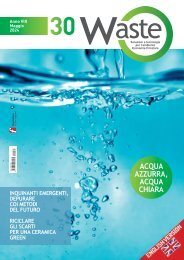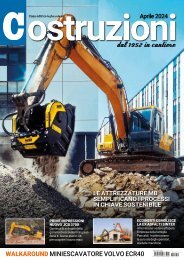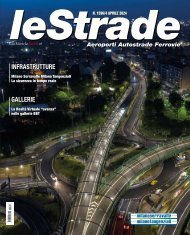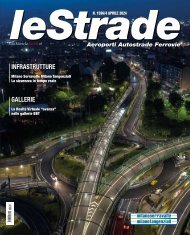LeStrade n.1563 dicembre 2020
MONOGRAFICO Numero dedicato alle reti stradali INTERVISTE In esclusiva Anas e Commissione EU SPECIALISTI Norme, sicurezza e alta tecnologia
MONOGRAFICO
Numero dedicato alle reti stradali
INTERVISTE
In esclusiva Anas e Commissione EU
SPECIALISTI
Norme, sicurezza e alta tecnologia
- No tags were found...
Create successful ePaper yourself
Turn your PDF publications into a flip-book with our unique Google optimized e-Paper software.
80<br />
81<br />
LS<br />
Infrastrutture Intelligenti<br />
Il passo veloce<br />
delle strade digitali<br />
L’Azienda / The Company<br />
SINELEC è l’azienda tecnologica del<br />
Gruppo ASTM, secondo gestore al<br />
mondo di reti autostradali a pedaggio<br />
in concessione, di cui raccoglie le competenze nell’ambito del<br />
pedaggio elettronico, dei sistemi di trasporto intelligenti, nonché<br />
delle telecomunicazioni e delle soluzioni IT. SINELEC è attivamente<br />
coinvolta nel processo di digitalizzazione delle infrastrutture<br />
dei trasporti in Italia che consentirà agli operatori<br />
stradali di affrontare le sfide della mobilità futura, quali l’introduzione<br />
di veicoli autonomi, auto elettriche e nuovi modelli di<br />
mobilità basati sulle connessioni digitali dei trasporti, al servizio<br />
della crescita del paese e del benessere dei cittadini.<br />
1<br />
SINELEC is the technology company of the ASTM Group, the<br />
second largest toll road operator in the world and a global player<br />
in the engineering and construction of major infrastructural projects.<br />
The company gathers together the technological expertise<br />
of the Group in the fields of Electronic Tolling, Intelligent Transportation<br />
Systems, Telecommunications and IT solutions. SINELEC<br />
is actively involved in the digitalization process of Italian transportation<br />
infrastructures, enabling road operators to face future mobility<br />
challenges such as the introduction of connected-autonomous<br />
vehicles, electrical cars and new mobility models based on<br />
the digital interconnection of transportation services, in the service<br />
of the growth of the country and for the well-being of citizens.<br />
Gli Innovatori<br />
DAI PROBLEMI DI SICUREZZA, CONGESTIONE E INQUINAMENTO<br />
ALLE SOLUZIONI, CHE POSSONO ARRIVARE DALLA<br />
TRASFORMAZIONE DIGITALE DELLE NOSTRE RETI VIARIE.<br />
IN QUESTO CONTESTO, RACCONTIAMO L’ESPERIENZA DI SINELEC<br />
(GRUPPO ASTM), PARTNER ATTIVO DEL PROGETTO SMART ROAD<br />
ANAS, AL LAVORO SU TEMATICHE CRUCIALI COME I VEICOLI<br />
CONNESSI E LA PESATURA DINAMICA DEI MEZZI PESANTI PER<br />
IL MONITORAGGIO DELLO STATO DELLE OPERE.<br />
Loretta Corti<br />
Marketing & Communication<br />
SINELEC SpA<br />
Valter Gavello<br />
Head of Sales & BD<br />
SINELEC SpA<br />
Approfondisci<br />
Delve deeper<br />
1. SINELEC è attivamente<br />
coinvolta nel processo<br />
di digitalizzazione<br />
delle infrastrutture<br />
dei trasporti in Italia<br />
English Version<br />
The fast pace of digital roads<br />
FROM THE ISSUES OF SAFETY, CONGESTION AND POLLUTION TO THE SOLUTIONS THAT ARISE FROM THE DIGITAL<br />
TRANSFORMATION OF OUR ROADS. IN THIS CONTEXT, WE DESCRIBE THE EXPERIENCE OF SINELEC (ASTM GROUP),<br />
AN ACTIVE PARTNER OF THE ANAS SMART ROAD PROJECT, AT WORK ON CRUCIAL TOPICS SUCH AS CONNECTED<br />
VEHICLES AND WIM SYSTEMS FOR INFRASTRUCTURE MONITORING.<br />
Gli Innovatori<br />
The infrastructure and transport sector has a fundamental role<br />
in a country’s growth. The increase in world population has resulted<br />
in the growing use of infrastructures, with an impact on<br />
road safety, public health and climate. Around 1.3 million deaths<br />
are recorder on the roads annually, whereas 20-50 million people<br />
are involved in non-fatal accidents (WHO data from <strong>2020</strong>).<br />
Additionally, transport is still one of the main sources of pollution<br />
due to fine particles and CO2 emissions. Just two years ago,<br />
in 2018, the World Economic Forum estimated global productivity<br />
losses of US$ 1.4 trillion caused by congested traffic. Signs<br />
of change begin to emerge in this scenario, attributable to three<br />
disruptive macro-trends - electric vehicles, connected autonomous<br />
vehicles and shared/interconnected mobility models (MaaS)<br />
- which testify to the drive towards “greener” and safety-focused<br />
choices, such as multimodal transport solutions that reduce the<br />
number of vehicles in circulation. Infrastructures and their digital<br />
transformation cannot avoid being an integral part of this path towards<br />
the future.<br />
12/<strong>2020</strong> leStrade<br />
1. SINELEC is actively<br />
involved in the<br />
digitalization process<br />
of Italian transportation<br />
infrastructures<br />
New ecosystem<br />
The digital transformation process of transport infrastructures is<br />
still not as advanced as it is in other sectors, but it is now an indisputable<br />
fact that road networks and Control Centers must evolve<br />
in order to become an integral part of a new and connected system.<br />
Control Centers will have to interact in real time with infrastructures<br />
and vehicles to manage the new flows and offer high<br />
added-value services. Road will essentially inform, suggest alternative<br />
routes and “organize themselves” based on actual and expected<br />
traffic. They will be interconnected structural elements that<br />
will proactively maintain their operational status and communicate<br />
with service providers in order to guarantee simpler and safer<br />
travel experiences, while reducing congestion and pollution.<br />
Smart infrastructure will become a service platform that will redesign<br />
the approach to mobility, no longer only concentrating on the<br />
individual, but on the movement (and needs) of the community.<br />
This is a vision that embraces the sustainability principles of the<br />
2030 Agenda for Sustainable Development and the Horizon <strong>2020</strong><br />
European Green Deal programme. Smart mobility will also be a<br />
priority subject in terms of the Recovery Fund projects in Italy<br />
which will see a portion of resources allocated to transport digitization<br />
(the <strong>2020</strong> Documento di Economia e Finanza [The Annual<br />
Economic and Financial Report from the Italian Ministry of the<br />
Economy and Finance] calls for a 637 million investment in smart<br />
road initiatives). The digitization will involve a significant number<br />
of projects in both urban and extra-urban settings. It will impact<br />
existing roads, bridges and viaducts and will be an integral part of<br />
new constructions. The networks of the future must be able to<br />
manage connected autonomous vehicles (CAVs) while going<br />
through intermediate phases. In this sense, the road operators<br />
sector is working to define a classification system for the various<br />
degrees of infrastructure digitization to be implemented based on<br />
12/<strong>2020</strong>







